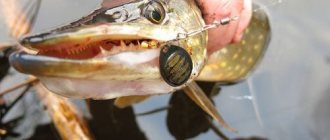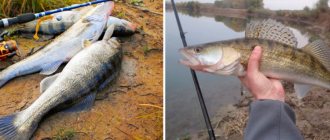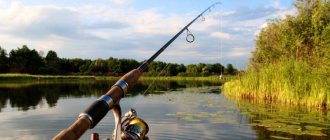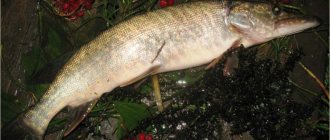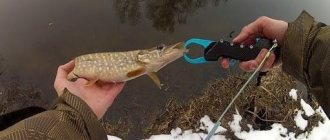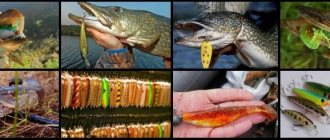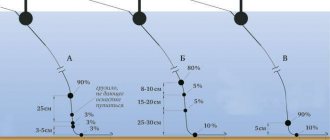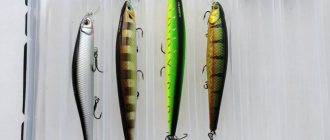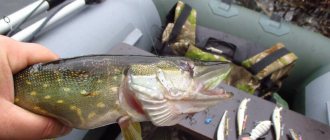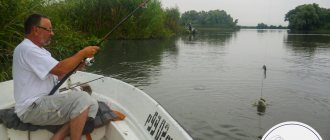To choose the right lure, the location and depth of the reservoir is taken into account, but first of all, you need to focus on the season , then the catch results will be much higher.
Pike is a cautious and cunning predator, but with the advent of baits such as spoons, these advantages lose their importance. At any time, and especially during the feeding season, with the help of a huge variety of baits you can count on a catch. The voracious hunter rushes at the object imitating a fish, not noticing the catch.
The advantage of fishing with a spoon is that it is a reusable item if made from quality materials. In addition , the bait can be constantly changed until the optimal option is found and the chances of good catch increase.
Best period for fishing
The chances of a successful catch increase during the pike feeding period. At this time, you can count on a trophy specimen. The main thing is to correctly determine this period, which depends on the type of reservoir, regional location and weather conditions.
The predator fattens twice a year: in spring and autumn , and the first fattening does not last long - one or two weeks. However, pike are very active and catch these days is guaranteed, provided that the lure is selected correctly.
Spinning fans leave all their business at this time and go fishing with a supply of different types of bait, reasonably counting on an unforgettable catch of a large predator. Experienced fishermen consider the beginning of the spring feeding of pike to be the moment when the rose hips begin to bloom.
For effective fishing, you should know not only the habits of the predator, but also the characteristics and properties of the spinners. To accurately determine the required option for a given reservoir, you need to take into account the weather and fishing season. Therefore, you need to be able to understand the variety of baits.
In the water, the spoons sway rhythmically from side to side, and hypnotize the pike: it mistakes the spoon for a small fish and is caught on the hook.
Unhooked
Non-hooking ones come in different colors and types. A distinctive feature of the bait is a hook (single or double), the tip of which is protected from snagging by a magnet or a metal tendril/tendrils. Its sting opens only at the moment of attack.
Non-hooking fishing rods are used for catching pike in reservoirs with an abundance of algae, organic debris (branches, snags) or stones.
During the retrieve, this bait attracts pike with its rotating movements, for which it got its name. In addition, it also sparkles in the sun. Spinner baits are most often caught on lakes, quarries and small ponds.
Types of spinners for pike fishing
To figure out which lures to use to catch pike, you need to take into account many factors, which include the depth and topography of the reservoir, as well as the season and time of fishing. To understand what kind of bait you can use to catch a predator, you need to study the preferences of the fish.
The color of the spoon will depend on the time of day and the turbidity of the water . It is recommended to adhere to the following rules:
- In the early morning and evening, spinners with a silver tint are used. On a sunny day, dark and bright baits are chosen, and on a cloudy day, they prefer golden and silver colors;
- when catching pike with an oscillating spoon, you can use a different color palette, from bright to white shades;
- spinners can also be used in different colors. A larger predator bites on a silver, matte bait.
Attention! The best result is achieved when choosing bait taking into account the color scheme of the fish living in the reservoir.
In addition to color, you should pay attention to the shine and texture of the bait . Experienced fishermen recommend using matte lures, as pike can be scared away by the mirror surface. Purchased glossy bait can be rubbed with sandpaper and made it less shiny. The texture should be made as an imitation of scales .
The weight of the spoon is determined by the tackle used and the characteristics of the reservoir . Light baits are used when using a soft fishing rod and in reservoirs with weak currents.
The choice of bait depends on the fishing season:
- In spring , pike bite well, as it begins a period of active feeding. The best spinners at this time are rotating ones , as well as wobblers .
- In summer , the fish become calmer, so rotating spoons up to 8 cm long and of a dull color are used for fishing.
- In autumn, pike prefers heavy and long oscillating spoons .
- In winter , the probability of catching a large fish is very low, so small lures of a calm color are used. The color should not be too bright, but not dull either.
Choosing a spinner for pike fishing is a rather painstaking process, during which many factors are taken into account. It’s best when you have several options in your arsenal, from which you can choose the most suitable one.
Hesitating
Oscillating spoons have held a leading position among pike fishing lures for many years. The range of oscillators is very wide, there are the following types:
- classic spoon-shaped spoons ;
- A popular type are fish-shaped ;
- Shtorling - such a spinner looks quite angular, with a slight change in width;
- curved oscillators , which are called “Wave”.
The principle of operation of the spinner is that the spoon imitates the movement of a sick fish and creates vibrations in the water, which attracts a predator.
Even a beginner can catch a pike with this bait. Reference! Recently, bimetallic baits have been gaining popularity. They convey color alternation well and produce a weak EMF. Thanks to this, the spoon seems more alive.
Oscillators are considered the most effective and have many advantages:
- When deployed correctly, the spoon creates vibration in the water, which attracts predators and increases the chance of a catch.
- Spreaders are equally well suited for various bodies of water. Much of the popularity of spinners is due to their versatility.
- The tackle can be thrown at a distance of up to 70 m.
- Spinnerbaits have a low price compared to other popular spoons.
Thus, spoons are a universal tool for catching pike. You can use such a spinner even without special skills.
Rotating
The turntable got its name due to its design. The spinner is a metal rod around which the petal rotates. Under the petal there is a core and a treble hook. The action of the bait is ensured by the movement of water.
Compared to spoons, spinners do not look like real fish. The spinner attracts pike due to the sound waves that are formed during rotation.
Carefully! Experienced fishermen note that bright spinners are good for muddy water, and dark ones for clear water.
Turntables have the following advantages :
- There is a huge range of spinners, so you can choose a bait for different conditions.
- The turntables can be changed according to your preference. Each fisherman can improve the spoon by adding more petals or changing their thickness and shape.
- Pike notice the spinner at a distance of 15-20 m, so using bait you can attract a large number of fish.
The main disadvantage of spinners is that to get a good catch you need to have special wiring skills . A novice fisherman is unlikely to be able to catch a pike with such a spoon.
It is noted that if used correctly, you can catch trophy fish. Therefore, spinners are popular among fishermen.
Unhooked
Non-hooking spoons are improved spinners, the main feature of which is the hook. Lures are made in various shapes, colors and sizes, so choosing the right one will not be difficult. The tip of the hook is protected from snagging by a magnet or a metal tendril.
Many fishermen argue about the effectiveness of such bait. Therefore, the following advantages are highlighted:
- The non-hooking bait can be used in hard-to-reach places where other lures will be less effective.
- You can choose different lures based on shape, type of movement and color. The assortment of non-hooking ones is very wide.
- Suitable for fishing in swamps .
The disadvantages include:
- A hook that is protected from snagging may also not catch the catch.
- There is a high probability that the pike will fall off the hook.
- Non-hooking rods are used only with special fishing rods.
Thus, non-hooking baits are well suited for fishing in polluted and thickened waters. To get a good catch, you need to constantly control the hook of the spoon.
Lures
Spoons for pike fishing are varied, the only thing they have in common is the number and location of hooks. And then, you can often find baits with different numbers of hooks, which are located in different areas. True, the operating principle is somewhat similar.
The operating principle of baits is based on factors that irritate the predator. When hooked, it shines and creates vibrations under water, like a real fish. These movements provoke the pike to attack. This is what spinners are famous for – their simple operating principle and high efficiency.
Oscillating spoons
These baits stimulate the predator's senses through oscillating movements. The shine in combination with sounds and imitation of fish behavior often attracts predators from distant points in the reservoir, so it is not necessary to carry the tackle under the nose of the fish to catch it.
Most often, pike are caught using oscillating spoons in the fall, since the predator flatly refuses to respond to other baits. It is at such moments that the advantage of the spinner over wobblers and other baits manifests itself.
Spinners
Fishermen often call these baits spinners. This bait is not as simple in structure as the previous one. It consists of a short rod to which a swivel and leash are attached. And at the other end of the rod there is a hook and a petal.
During the retrieve, this bait attracts pike with its rotating movements, for which it got its name. In addition, it also sparkles in the sun. Spinner baits are most often caught on lakes, quarries and small ponds.
Spoon jigs
The cylindrical design of jigs is their characteristic feature and the main difference from other pike lures. Such baits are designed for fishing at great depths and have a relatively large weight. The wiring methods are no different from the classic options.
Unhooked
The main feature of the structure of such a bait is a metal rod that protects the hook tip from snags. When a pike bites, as soon as the angler makes the hook, the rod bends and the hook tip comes out, securely clinging to the jaw of the predator.
This is really an excellent bait for catching pike, because very often you have to fish in thickets of aquatic vegetation and snags, and that’s where the pike stands. But, without the lack of certain skills, it will be difficult to spot the fish.
We recommend watching a very useful video about catching pike with a spoon:
Removing the hook with tools
How to properly pull a spoon out of a pike's mouth? Have you looked into this mouth? Many small and sharp teeth directed inward. In addition, he has fangs like a good shepherd dog. It seems that you can’t get anything out of there, including your hand, if the pike has closed its “trap”.
And this is really a trap. Whenever you touch the pike's head, especially when trying to put something in its mouth, there is a lightning-fast click and the trap immediately slams shut. Moreover, it slams shut with such force that it seems as if wood chips will fly from the stick they are trying to open the pike’s jaws with. The muscle strength of pike jaws is incredible. And, probably, all fishermen have once received wounds from pike teeth, especially in childhood or when they were just starting their fishing career. Do you remember how long it took for wounds from pike teeth to heal? A pike, of course, is not a snake, but there is something like cadaveric poison on its teeth, and fish, as you know, do not clean their teeth...
What to do if a pike swallows a spoon? Much depends on what will be done with the caught prey later. If she goes for food, which seems more natural to me than engaging in games of catch and release, then there is a very decisive and almost always effective technique. It's called “over the head.” In winter, this is done with a sharp blow of a scoop, which is used to clear the hole of slush and ice crumbs. And, believe me, this is much more humane than walking along the shores of reservoirs in beautiful suits, advertising brands and baits, and for this, catching live fish, dragging them, causing pain and stress, and then, showing off, releasing them back. A man is a breadwinner, he was and remains, despite our time, when many men turn into women. In addition, I suspect that many people simply do not eat fish. But real fish-eaters and fishermen know a lot about well-cooked fish and, for the most part, cook it themselves, not allowing a woman to take part in such an important task. You say, you can buy fish in the store. No, only freshly caught fish, straight from the water, is considered first fresh fish. This, of course, does not apply to dried fish, smoked fish, or balyk. There are other categories here.
As for the impoverishment of reservoirs, electric fishing rods, gentlemen, factory owners, and fishermen who fish with nets, blocking spawning grounds, have a hand in this, and take much more than what they need for food. A fisherman with a spinning rod, a fishing rod, and even a net, as in Sweden and Finland, will not cause harm to nature if he follows his internal law and fishing standards.
However, pike are not necessarily kept alive only for expert filming. It’s just that if you’ve been fishing for several days, and the water in the reservoir is cool, or better yet cold, then in order to keep the fish fresh, the only way out is to keep it on the kukan.
But let’s get back to how to correctly pull a spoon out of a pike’s mouth. So, after a sharp blow to the fish’s head, the pike, as a rule, opens its mouth wide. Moreover, if it is only stunned, then this will allow you to get the spoon without much difficulty. Often the spoon itself falls out of the pike’s mouth. But at the same time, there is no need to try to put your hand into the pike’s mouth. No matter what, there is a possibility that the trap will still slam shut. Therefore, in order to calmly get the bait out of the mouth of a pike, there are several basic tools, and if you have them, the question will not arise: what to do if the pike has swallowed a spoon.
So, one of the useful tools in such cases is a surgical clamp. Although it is not one of the most used tools for removing spoons from the mouth of a pike, nevertheless, many people use it, especially when catching small pike. In fact, this is an analogue of an extractor, only not the more common fork one, but in the likeness of special pike narrow-nose pliers. Only the clip is thinner and more elegant. Originally intended for smaller pike.
I admit, although I am ashamed that I still have an extractor from a fork of a bush in my bag with the girders. Dried and strong as iron, soaked in pike mucus, it became a talisman for me. In fact, if necessary, such an extractor can be broken out or cut out of the coastal bush if a real metal fork extractor is not at hand. Such an extractor, of course, cannot serve as an example of how to correctly pull a spoon out of a pike’s mouth, but if there is a forced need and you don’t want to risk your hand, then such an improvised tool of biological origin will do.
Now another very important tool, probably the most important one, is the yawner. You really can’t do without it if you are not going to use the “over the head” technique, and after catching a pike you will need a photo session and a touching ceremony to release the fish into the water or you will need to keep it on a kukan. You can only open the pike's mouth to pull out the lure with the help of a gaper. Moreover, I have such a yawn from my father that when I open the mouth of a pike, I am afraid that I myself will be pinned by these powerful levers. If the yawner moves to the side and somehow falls off the pike’s jaws, then it’s better to immediately hide your head. There is such a force in the spring there. This speaks volumes about what kind of pike there were at that time. However, post-war newspapers also wrote about thirty-kilogram pikes in some of our lakes.
How to act and what to do if a pike swallows a spoon? Everything is simple here. The pike's mouth is carefully opened with a gaper, fixing it in the upper and lower jaws. Then, holding the fish with a gaper, carefully unhook the tee of the spoon using a fork or other extractor, moving it inside the fish. All that remains is to pull out the freed bait. Similar operations can be done using various narrow pliers and the already mentioned surgical clamp instead of a traditional fork extractor. Additionally, any strong fork of a branch can also be used as an extractor.
What color should the bait be for a predator to peck at it?
Recommendations for choosing bait color:
- dawn and dusk - silver shades;
- sunny days - dark and neutral tones;
- rainy weather - matte gold-silver;
- water with turbidity - bright, acidic shades;
- Pinwheels can have different petal colors; large specimens bite better on a matte silver color.
Rice. 6. When fishing with oscillating bait, color does not play an important role. You can take baits even in unremarkable colors, for example, white.
For many fishermen, pike fishing with a spoon remains a favorite type of fishing, despite the emergence of new and more advanced types of artificial baits on the modern fishing market. Let's try to consider the main parameters of fishing using spinners.
Gear requirements
When fishing for pike with a spoon, you need to select gear that will best suit the fishing conditions and allow you to use the selected models. The set can be either light or intended for heavy fishing. The most universal set will look like this:
- The rod is 2.40 meters high. Test for baits from 5 to 30 grams. Build medium-fast or medium. Blank with reinforced butt and movable tip;
- The inertia-free reel ranges in size from 2500 to 4000. The gear ratio is about 4.8:1. Even placement of thread on the bobbin. Sensitive friction mechanism;
- Monofilament fishing line is better, especially when using rotating spinners.
Good tackle is the key to success in pike fishing.
When fishing with lures, different types of leashes can be used. For spinners, it is better to use a rigid steel “twist” about 30 cm long. With spinners, you should fish on bends made of fluorocarbon fishing line or soft leader material.
Techniques and tactics for catching pike with lures in summer
If there are sufficiently wide expanses of water, fan casting methods should be used. This method greatly contributes to the fact that it will be possible to check as large areas of the reservoir as possible.
If fishing is carried out from boats, or when fishing on shore with a strong current, casting should be carried out strictly in the direction of the current. In cases where the surface of the bottom relief is largely studded with all sorts of obstacles, such as snags and other obstacles that can contribute to numerous hooks, the wiring should be done when the spoon touches the surface of the water cover.
When carrying out wiring processes, you should imitate the life processes of living fish as accurately as possible. This method greatly contributes to the activation of the hunting instincts of pike, and therefore significantly increases the chances of a good catch.
It is also necessary to immediately hook the predator you encounter, so as not to give it time to come to its senses and try to escape. The cutting process is quite sharp in its parameters.
Advice from professionals
Experienced professional fishermen recommend that when carrying out casting processes, try to produce fairly loud sounds when the spoon itself hits the surface of the reservoir. It is not known why, but representatives of the pike family fall for this trick, although they do not like loud sounds.
Do not try to leave your fishing spot after the first catch appears. In most situations, these predators will stay in small flocks, therefore, after catching the first individual, collecting it after some time, which they need to calm their nerves, they will continue their hunt.
You should not create excessive or loud noise when carrying out the processes of catching individuals of the pike family. Many representatives of this type of fish tend to leave the area where suspicious and unnatural noises were heard.
The range of baits used to catch a predator can confuse an inexperienced fisherman. In fact, there is nothing extraordinary when choosing them. Russian pike is quite unpretentious, so the fisherman’s arsenal is focused on three areas:
Fishing for pike with a spoon
Spoon baits are still popular, despite all the efforts of companies producing new baits for catching predators. Oscillating spoons are also popular because they are easy to catch. They forgive wiring flaws.
Moreover, pike often take just any kind of wiring. Apparently the fish sees in the unevenly twitching spoon a completely wounded creature and easy prey. The spinner catches immediately after falling into the water - playing while diving. This fishing technique cannot really be repeated with any other bait.
And refined techniques for guiding spinners allow you to achieve the largest pike catches. Many anglers claim that it is the spoon that brings the most trophies compared to other baits. But how do they achieve this, how to successfully catch pike with a spoon? Nothing complicated, simple techniques...
Wiring Features
Playing at great depths with small and medium-sized spoons is almost impossible. At depth, only a heavy, oscillating spoon can be used successfully. But it can also be carried out in the middle layers of water.
Pike also prefer medium and large spoons. Moreover, the colder the water, the closer to winter, the more relevant a large heavy spoon becomes.
The simplest wiring of the vibrator, but very effective - uniform movement. And that’s it – the spinner does its job! For beginner spinners - a fairy tale...
The usual rule for catching pike with a spinner is to make the retrieve as slowly as possible, at the limit of the spinner’s ability to oscillate when moving.
But it is important to know the desired horizon and maintain it. For example, in the fall, pike loves depth and stands on the edges, slopes into the hole. You need to lift a heavy spoon along the edge from the depths, or even better, from the opposite direction, roll the spoon from the shore to the depths, imitating the usual movement of prey. In summer, there are a lot of pike where small fish are found - in overgrown shallow waters. And here there are some peculiarities of fishing.
A decent pike took the bait on a dive near the reeds
Unhooked ones are caught in shallows and snags
In summer, overgrown shallow waters are just suitable for light spinners. And the main predator is the grass pike, not large, but very aggressive towards the spooner that makes its way between the stems.
Non-hook spinners are spinners in which the hook is covered by metal antennae to prevent accidental snagging. Indeed, they can be carried out along snags and grass - very promising places for fishing. When the pike grabs the bait, the antennae contract and the predator gets hooked.
It is believed that on a non-hook it is better to use a single rigid hook protected by antennae. It catches pike more effectively than a tee with such protection. More information about catching pike in the grass with a wobbler
But if we talk about the effectiveness of fishing with various baits, then there is an opinion that with an oscillating spoon the percentage of strikes during bites is higher than with any other baits. This is due to the shape and material - the spoon easily slips through the mouth, and the hook reaches the target faster.
Various spinner game options
With uniform wiring everything is clear - effective, but according to the mood of the fish. If the pike is lethargic and stubbornly does not want to take a simple movement, then you can tease it. Make an up and down motion, like a step. The fall of the spoon is very effective. Performed as winding with pauses.
Another variety of wiring is to place the spoon on the bottom, then lift it to create turbidity. The predator comes running to such an event.
The next twitching movement is a jerky reeling and twitching with the tip of the fishing rod.
Using these combinations, you gain your own experience in “driving” the spinner. But when the pike is actively greedy, a simple uniform movement of the spoon is enough. It should be taken into account that uniform wiring is the most rational. With it, the overall speed of movement of the spoon is greater, and a larger area is fished during the activity of the pike. As a result, there is a greater likelihood of encountering a predator and a greater number of bites.
Primary catch on the fall
The spinner plays on the fall. The predator reacts to it. It is better to first check an unfamiliar place with a fall technique. The point is that the oscillating spoon is allowed to sink freely. A pike, if it is close in ambush, may well take it right there. But more often it happens a little differently.
The spinner, plunging, attracts a predator to the place, especially if the depth is deep and an interested pike approaches the object for exploration. After this, the spoon is allowed to lie on the bottom for a minute or more - so that the pike comes up and gets used to the situation - the fish needs time to study. Then the spoon is lifted from the bottom to create turbidity, at which time the bite occurs. The pike is guided by a reflex - as soon as the object begins to run away, it takes it.
This is how they fish for snags sticking out of the water, they fish for reed walls and vegetation in windows. But even in open water, at depth, it is useful to begin examining a place with a free dive.
Seasonality of fishing
Cold water in spring and autumn, the concentration of fish in holes, require the angler to adapt to the behavior of pike - to fish at great depths along the edges. The wiring is usually stepped, often with dragging along the bottom. The spinners are heavy. Sometimes fast retrieval is better - the pike still takes, and the catch is wider.
In summer, in warm water, the opposite is true - lighter lures, higher stroke, above the grass, above the snags. Even at depth - at half-water. The usual technique of a predator is to stand lower, merging with the bottom, and attack from the bottom up. This is how they catch summer pike. But the wiring is only extremely slow, mostly uniform. Light oscillating spoons actively play with this movement.
It turns out that pike can be successfully caught not only during the day but also at night. How to catch pike in the dark - new article.
taut line
When doing any wiring with an oscillating lure, you need to learn to keep the line taut. This is especially true for the fall phase of the spinner. With a tight line, the bite is easy to detect. And with a slack bite, the bite will go unnoticed.
The pike quickly determines that it has grabbed something unnecessary and frees itself from the spoon. With silicone, for example, there is still some reserve of time, especially if it is odorous, then the pike may try to drag it away. But with a spinner, the catch for the fish is obvious, so more often the predator tries by all means to part with the foreign object. To prevent the pike from spitting out the bait, you need to constantly monitor the movement of the fishing line and make a quick hook if there is any suspicion of a bite.
Shine matters
In clear cold water, golden and silver, highly reflective vibrators tend to work worse. They probably create a light effect in such conditions that is too bright for the fish. Therefore, in the fall, fish most likely will not like silver and golden “beauties”. You need something dark, blued, gloomy-looking and not colorful. In general, color and reflection matter to a spinner.
In summer, when the water is cloudy, shiny ones, on the contrary, more often tempt pike. Most likely, the increased light visibility in such water is a useful addition to the sound stimulus. Of course, this is not a hard and fast rule, but you need to remember about the selection of color and light.
Fishing from a boat
Fishing from the shore is significantly limited. Being on the shore, you cannot reach or reach the best edges, windows of vegetation, snags and simply great depths, where they mainly catch trophy channel pike with heavy lures...
But with a boat, the choice of fishing spots expands beyond words. Especially if the vessel is equipped with at least an electric motor. Fishing from the shore, casting under the wall of reeds and much more becomes available.
It is equally important that the hook of the spinner is no longer its last act of action. On a boat, using a heavy hitch and a long stick, you can solve such problems. Moreover, branded modern spinners are not cheap. And which of the spoons are more catchy?... It’s better to look for answers yourself in fights with pike in summer and autumn. Read more - what techniques can be used when fishing with a spinning rod
Necessary gear for pike fishing
We will not describe the choice of spinning rod; we have already dwelled on its characteristics more than once. If anyone doubts their choice, they can carefully read this article. Let's talk about how to choose a reel, fishing line, bait and mount the right equipment.
A medium reel is suitable, with indicators of 1500-2500 according to the international classification. On its spool it is free to fit within 100 m of fishing line. It is enough that the reel is equipped with at least three bearings. It is desirable to have a friction clutch; unlike pike perch, pike resists much more actively when fishing.
The preference of the line depends to some extent on the bait. The blow of a pike when biting is quite sharp, so there are no requirements for its sensitivity. For jig, you can wind braid on the spool; for other lures, you can get by with monofilament.
The leash is much more serious; a pike in the forest can easily bite through its teeth. The choice is made between three types:
- Kevlar;
- steel
- tungsten
By the way, you can make it yourself; for this you will need a guitar string. Loops are twisted at its ends, onto which swivels are pre-mounted.
In principle, you can go directly to the equipment, the classic version of which is indecently simple. A leash is tied to the main line, and on the other side the bait is attached to a clasp with a swivel. There are also supporters of leadless gear, citing the timidity of squinting fish. However, if catching a large pike with a spinning rod from the shore leads to the capture of a trophy specimen, it will be quite a shame to look at the bitten line.
The principle of operation of such bait is to produce certain vibrations and flashes under water, with the help of which the fish are carefully lured onto a hook thrown into its habitat.
What is a spinner?
In the fishing community, a spinner is usually called a type of bait, which is characterized by the presence of one or several hooks, and with the help of its appearance creates an imitation of a small fish or insect.
It usually looks like a small metal petal and comes in a variety of colors.
The principle of operation of such bait is to produce certain vibrations and flashes under water, with the help of which the fish are carefully lured onto a hook thrown into its habitat.
Among the variety of models presented, in order to purchase exactly the option that will most satisfy all the tasks at hand, it is necessary to consider in more detail all existing types of this bait.
These include the following types:
Oscillating spoons
Based on the name, you can understand that the operating principle of this bait consists of oscillating movements , to which any predatory fish actively reacts.
Thus, by performing such vibrations, a fairly believable imitation of a small fish is created, attracting the attention of prey with the shine of its metal plate.
On one side of such a spoon a hook is attached using a swivel, and on the opposite side - a fishing line. The use of this type of bait in the autumn may appeal to all predatory fish, which react very actively to oscillating bait before the start of winter.
Spinners
Among fishermen you can also find such a name as turntables. Such models are distinguished by a rather complex design , consisting of a five-centimeter rod, which is attached to the leash using a winding ring on one side.
Hooks, an anchor and other devices are already attached to the other end. Thanks to its rotational movements, this lure quickly attracts predators and forces prey to fall on your hook.
Spoon jigs
A distinctive feature of such artificial bait is the presence of a certain cylindrical shape , and its use is most often aimed at casting fishing.
Spinner “not hooked”
Its main secret was a special manufacturing technique , thanks to which the hook is securely hidden under a metal mesh and comes out only when the fish swallows the bait inside.
It is this technique that helps the fisherman avoid any snags that negatively affect the quality of the gear used.
It's important to feel the bait so you know when to use an extra jerk or twitch to provoke an attack from the toothy fish.
Fishing for pike with a spinning rod in the fall from the shore
In our article on how to properly catch pike with a spinning rod from the shore, experts involved in the Fishing Sports Federation, as well as avid amateur fishermen, share their experience. When choosing a place for fishing, you should give preference to steep banks - the predator lives in such places all year round. A bridge support can become a haven for hunting fish. It is worth settling near areas near overpasses. In cloudy weather, fish move to deeper water areas.
To understand when it is better to catch pike with a spinning rod in the fall, you should study the behavior of pike by month. If in September it still lives in the shallows and shallow waters, preferring reed thickets, then in October the fish goes deeper, which complicates the process of coastal fishing. This problem is easily solved with the help of a suitable spinning rod.
Anglers note that pike hunting in October is most productive. The toothy beauty becomes more aggressive, as a result of which it reacts literally to every provocative movement of the bait. The best weather is cloudy, with a weak wind raising small wave ripples.
In November, the pike shifts to deep waters - on the nose they go to wintering pits. But this does not prevent the predator from continuing to feed in the afternoon and evening. During this period, fishermen use wobblers, silicone and spoons. Let's look at which leashes are best to use for catching pike with a spinning rod:
Posting baits carried out at changes in depth and slopes produces the best fishing. Spoons and wobblers of medium and large size, as well as silicone 10-12 cm in length demonstrate the greatest effectiveness:
With a boat it is convenient to approach deep-water areas, to which the fish move from mid-October. It is unlikely to find a large pike in shallow water. Preferred deepwater sites are:
Places of tributary confluence.
When fishing on shore, spinning rods with rods up to 3m in length help out. Fishing for pike with a spinning rod in the fall on the lake using a watercraft will allow you to reach deep-water areas.
Individuals of trophy size (more than a meter) are considered especially voracious, capable of pulling under water and eating mice, rats and waterfowl during their molting period. The birds simply do not have time to take to the air. Often, a large pike attacks a fish that is only half its size.
Catching pike with rotating lures: selection, fishing, nuances of application
What kind of turntables does the catfish like?
Pike loves significant, noticeable prey that pleases the eye, so the choice of the size of the spinner should be appropriate. According to the Meps classification, these are numbers 2-5.
Large spoons are not only more noticeable visually and acoustically, but also allow you to work in deeper places in reservoirs, where predators often hide.
Sometimes, for summer grass pike, which hunt almost at the very surface, rotating sizes 1-1+ work well, but this is rather an exception that needs to be kept in mind. So, such spinners are very good in flood lakes and oxbow lakes when catching pike along water lilies.
Dimensions and weight of Meps spinners - Aglia line
For pike fishing, both front-loaded spoons and rear-loaded ones (loading on the core) are used.
Mepps Lusox - front-loading spinner
Aglia Long Cast - a typical rear-loaded pike spinner
Core-loaded spinners are more versatile and allow you to work in a wide variety of conditions and fishing ranges. Particularly relevant during spring and summer, when pike often hunt in the middle layers of water.
Front-loaded ones are needed in the fall, when the predator rolls into the pits, as well as for fishing the deepest waters, when the predator stands and hunts at the bottom.
When choosing a petal shape, you should start from the fact that there is no universal solution and its shape is selected based on fishing conditions. The narrower the petal, the faster you can move the spoon and the stronger the current can be when fishing. You can’t get hung up on one bait.
Petal shape according to Meps classification
More information on how to choose the shape of the petal for different fishing conditions can be found in the material about Mepps spinners.
Also, when fishing for pike, spinners are also used - tandems with two petals. They are more voluminous and create the strongest double vibration at the lowest wiring speed.
For catching catfish, clampless spinners of the “in-line” type with large numbers from 2 and above are also used. They are especially good in currents, as they start at the slightest fishing speed and do not lose their play when in contact with underwater vegetation.
Blue Fox Vibrax Bullet Fly - clampless spinner
It is also worth paying attention to this type of rotating spoons, such as spinnerbaits - more details about catching pike with such baits in our material on the topic.
Feeding and guiding rotating lures to pike
The basic rule when catching pike with spinners with a rear load is that the spinner should be carried out on the slowest lazy retrieve, on the verge of petal failure . It is precisely this monotonous, uniform wiring that almost always gives the best result. The petal shape, size and weight are selected according to the conditions in such a way as to achieve this result.
Spinners with a load in the front part are carried out not only with a slow, uniform step, but also with a long step jig (the phase of horizontal wiring in one step is at least 2-3 meters) or with a wave-like animation along the bottom or in the water column. This is dictated by the optimal conditions for their use, which is discussed below.
The selection rules depending on the depth and strength of the current are as follows:
- The greater the depth, the narrower the petal we use (in gradation from greater depth to lesser long-comet-aglia).
- The stronger the current, the narrower the petal we use.
- In calm water, the depth of fishing for an aglia type petal is from 0.5 to 1.5 meters, a comet is 1.5-2.5, a long one is from 2 meters to 3-4 meters.
- In the deepest holes of 3 meters and more, we use front-loaded rotators, varying the size of the weight depending on the depth. It is these spoons that allow you to probe the bottom in deep places, which is extremely important when catching trophy pike.
- During the current, everything depends on the strength of the stream and the direction of the wiring (upstream, across or against the current) - it is selected experimentally.
On a regular fly, you need to choose an option so that the back of the spoon seems to fall down relative to the muzzle by 30-45 degrees, without disrupting the operation of the petal. This option, as practice shows, is preferable to a perfectly horizontal position of the spinner.
It is worth knowing that some spinners with front loading allow you to remove the weight completely, and then they can be used as light but large spoons for fishing the upper layers of the water area (from 0.15 to 1-1.5 meters, the most effective way to catch pike is with such a spoon in the summer in the sun and on overgrown reservoirs, where surface wiring is indispensable).
Mepsian Lusox without weight provokes a predator fattening near the surface to grab it
It is important to thoroughly work out all working depths using different types of rotators, since pike can stand in any layer of water. We pierce the bottom (depth 5-8 meters) with front-loaded heavy pinwheels with a short step along the recesses, a little higher with a long step, then with long-shaped petals from 3-4 meters, above with comets and on top with aglias.
It’s also good that large pike rotating spinners can be felt in the hand even at the lowest fishing speed, which improves the quality of the entire fishing experience. This also allows you to fish with less sensitive oak tackle, which is especially important for beginners who are not ready to shell out thousands of rubles for a Japanese spinning rod, reels and cord.
Moving on to the selection of specific models
Based on the fact that a large working spinner is easier to make than micro spinners in sizes 000-00-0, you can purchase large spinners for pike from not the most famous manufacturers, even the Chinese.
A selection of working spinners that, in appropriate sizes and colors, work on pike all season (a detailed review is here):
Blue-Fox-Vibrax Smith Niakis longhevy Mepps Aglia Fluo Daiwa Silver Creek SPINNER Smith Niakis Mepps Black Fury Myran Toni Mepps Long Mepps Lusox 3 Blue Fox Vibrax BFF3 fluo Mepps Black Fury 5 Maniac Polyglot Spinner Lusox Daiwa Silver Creek Blue Fox Vibrax Bullet Fly - clampless spinner Lucky John Bonnie Blade Blue Fox Vibrax Mepps Aglia Fluo Panther Martin Daiwa Silver Creek Smith AR Spinner Mepps Heavy Long
Advice! We recommend purchasing spinners with a point of attack in the tee area (edge, fly, cambric, etc.). Or create it yourself with your own hands.
Lucky John Bonnie Blade with edge on tee
Pike food
Pike is a pronounced predator, eating representatives of many other species that fit in its huge mouth. For this reason it is called the thunderstorm of water bodies. Preference is given to bleak, gudgeon, dace, roach, rudd, perch, and prickly ruff. Cannibalism has also been observed; fishermen have repeatedly discovered smaller relatives in the stomachs of captured predators. In the warm season, the menu is supplemented with small frogs and molting crayfish. With a meager food supply, the predator does not disdain insects, worms and other living creatures.
Individuals of trophy size (more than a meter) are considered especially voracious, capable of pulling under water and eating mice, rats and waterfowl during their molting period. The birds simply do not have time to take to the air. Often, a large pike attacks a fish that is only half its size.
The listed set is very conditional and each place needs its own preferred bait. Read more about the variety of pike baits here.
How to catch pike from the shore using a spinning rod
Let us immediately make a reservation that this material will not consider such advanced and specialized pike fishing methods as jigs, twitching, spaced rigs, jerking and others. Here we’ll talk about how to fish with spinning rods from the shore with “ordinary” baits - spinners, spoons, wobblers, silicone baits on classic jig heads and others that are accessible and easy to master for beginners.
Tackle for catching pike from the shore
Without harmonious, balanced gear with a good margin of safety, it’s not worth going out hunting for a toothy predator. This is a large fish with an aggressive disposition, which behaves sharply and powerfully when playing, often getting lost due to its underestimation and incorrectly selected rods, reels and fishing lines.
A spinning rod for fishing pike from the shore should have a length of around 2.40–2.70 meters. With such a fishing rod you can confidently go out onto any body of water. It will allow you to cast bait far if necessary, it is not so bulky and will not cause discomfort on the shore. Read an article about how far to throw a spinning rod here.
If you have the opportunity to purchase several pike rods, then for small reservoirs and short-term fishing, it is advisable to purchase a spinning rod with a length of about 2.10 meters, which is more convenient in such conditions.
For pike fishing, the best spinning rod will have a medium action. Such a rod casts well with large spoons, silicone or wobblers, and when fishing, it successfully absorbs the jerks of the predator and “extinguishes” the candles, which it often comes to. The bait test usually ranges from 7–12 grams to 30–35.
The reel is preferably universal with a gear ratio of no more than 1:5.5. High-speed spinners do not have the necessary power and are suitable for catching small pike. With power ones, it’s difficult to perform wiring at a fast or even medium pace - you have to turn the handle hard, which leads to fatigue.
How to properly catch pike with a spinning rod from the shore, cord or fishing line? It is difficult to give clear recommendations. Nowadays, most people prefer braids, which is not surprising. They have the following advantages:
- With the same diameter, the breaking load is higher, which allows the use of thinner cords. This in turn increases the casting range and the delicacy of the tackle.
- Inextensibility, providing high sensitivity of the gear. In addition, this allows for a more successful hooking.
However, fishing line is also not without its advantages. Its stretchability perfectly absorbs the jerks of the fish, which minimizes slippage when fishing. It works better with lures that spin it. These are various front-loaded spinners and some oscillating spoons. The cost of monofilament is several times lower, which is no less important in our difficult times.
Lures for catching pike from the shore using a spinning rod
Hunting for toothy fish with a spinning rod from the shore is possible with a wide variety of baits. Their approximate range, which it is advisable for a beginner to have at least several models, looks like this:
- Front-loaded spinners.
- Oscillating spinners.
- Wobblers that have their own game with uniform wiring (shads or cranks).
- A set of vibrating tails and twisters mounted on regular jig heads of different weights.
The listed set is very conditional and each place needs its own preferred bait. Read more about the variety of pike baits here.
How to fish with a spinning rod from the shore in shallow water in the summer, with what baits? Here it is better to have wide-bodied spinners, light spinners, and surface wobblers. Vibrating tails are less commonly used on light jig heads. In heavily overgrown areas, use oscillating spoons with wire hook protection or spinnerbaits.
How to properly fish with a spinning rod from the shore in the autumn? Here, on the contrary, baits that work better at depth come to the fore. These are silicone and heavy vibrators. You can use deep-diving wobblers, but fishing with them from the shore is not so comfortable.
Selection of gear for catching pike with a spinner
The choice of spinning rod for lure fishing is determined by several factors:
- The specifics and size of the reservoir. If we are talking about a small river or lake, then it is advisable to use a rod with a length of 2.10 to 2.40 meters with a test weight of 5 to 20 grams. If fishing takes place in a large, wide body of water with great depths, then it makes sense to use a larger fishing rod. In this case, it is preferable to use tackle measuring from 2.70 to 3 meters with a dough from 15 to 40 grams.
- Casting is done from a boat or from the shore. If you have a boat, then there is no point in taking a long rod, since casting it in this case will not be very convenient, and besides, long casting is not required when fishing with a boat. The best option would be approximately the same rod as when fishing from the shore in small bodies of water.
- The size and type of spoon that will be used. Mainly this factor must be taken into account when choosing a reel for a fishing rod. For example, “oscillators” do not create strong pressure on the reel mechanism; therefore, almost any inertia-free reel will do. If the bait is a “spinner” with a large number, and the wiring is carried out against the current, then it would be more advisable to use a fishing rod with a multiplier reel. It will greatly facilitate the task of fishing for trophy specimens.
- It is preferable to use a fishing line that is not very thin - from 0.25 to 0.28 mm in diameter. Braid from 0.1 to 0.18 mm is also suitable.
